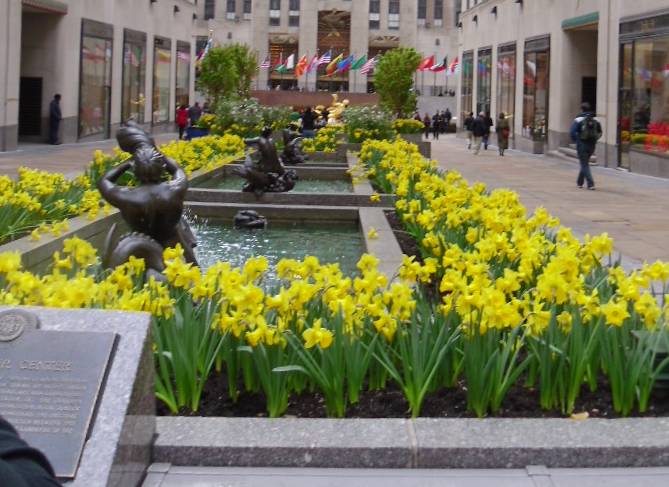| Back to Back Issues Page |
 |
|
Useful Community Plus March 18, 2021 |
Feature: Community "To Do" List for Spring, Lots of New Stuff on the Website, Much More
March 2021
Visit us at the Useful Community Development Website 
NBC Plaza, New York, in daffodil season
With that in mind, it's not too late to plan a park cleanup in your neighborhood. Although you need to think ahead, as events go, they are simple to plan and execute, and very gratifying to those who like to see the results of their work in a matter of hours, not days or years.
For specifics, start with our cleaning up your neighborhood park page and then if you have a larger park that will take more than a half day, see the large park clean up article.
Of course, it's also a good time to plan and execute a stream cleanup, neglected property cleanup, or alley cleanup.
Finally, help your newsletter editor by pointing out our spring newsletter ideas and even summer newsletter tips.
We have updated each of our 13 user-oriented lists of links on the website that cut across our topical area. These are accessed through clinking the links in the yellow box near the top of the sitemap page.
This month we also added .pdf files for people who have an arts and community development interest, a CDC interest, and a code enforcement interest, making a total of 16 very useful lists.
For instance, if you are a neighborhood leader, you might be interested in pages from our community organizations, crime prevention, housing, economic development, and sustainability sections. So on the sitemap page, we now link to a pdf that lists out the many pages across all sections of the site that might be of interest to the neighborhood-scale leader.
The other
lists deal with rural, suburban, planning commissioner, local government official, congregational leader, greenway planner, distressed neighborhoods, and so forth. Find the links to all of these in the yellow box near the top of the sitemap page.
Unfortunately in our last newsletter, we gave the incorrect link for our substantially revised page on rural neighborhoods. Instead see, this one.
We also published major revisions to these pages: 2. Community cultural development,
which is now much more zoomed in on traditional, historically practiced, and participatory or communal arts, both visual and performing. Usually these fall outside the definitions of high art and often are practiced in minority or marginalized communities. But not always, as you will see.
3. Arts and economic development, which could almost as appropriately be titled arts and community development.
As usual, we also answered some website visitors' questions:
How a rural community can oppose a wedding venue
Restrictions unknown throughout six years of residency
Tell your city leaders they can participate free in a virtual event about smart cities on April 13-14. For those of you who don't know, smart cities is a catch-all phrase for technological approaches to intelligent urban mobility, energy, infrastructure, data management, urban mobility, resident engagement, and good governance. City elected officials, city managers, public works directors, technology officers, and city planners should find this highly relevant.
Our favorite rural development article this month dealt with the potential boost for rural Americans from clean energy.
For any of you who are thinking that a form-based code would be simpler than traditional zoning for your
community, we recommend a close reading of this article about building types in form-based codes.
Lastly, many of you represent middle neighborhoods, which are middle-income neighborhoods that are transitioning for better or often for worse. We recommend this resource for connecting with other middle neighborhoods and considering local solutions. We will be back on a Thursday next month. Feel free to reply to this newsletter with comments. For questions, please use the public-facing community development questions page on the website.
|
| Back to Back Issues Page |


